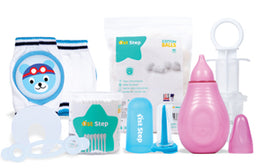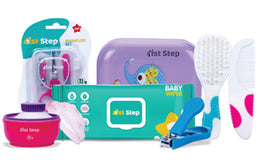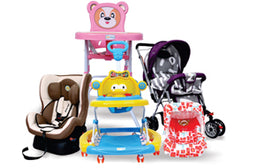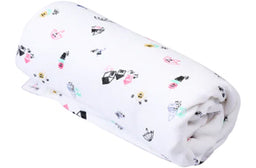11 Simple Activities for Babies 0 to 6 Months Old
No one said parenting needs to be tough and less of life. There are few fun activities for Parents and Babies to bond over in the first six months and create beautiful memories to look back on. So for your quality time with your baby, here are some giggle promised and safe activities to try with your baby.
Importance of your Munchkin’s Developmental Growth
A baby's first 6 years plays a crucial role in the development of a baby's cognitive activities. It is essential that a parent knows fun ways to engage the baby and spends time sculpting their motor skills, and language skills. It also helps in building a platform to develop the baby's emotional and social intelligence.
In this article you can find fun activities that promise to develop a bond between the baby and the parent through maximising quality time and providing beautiful memories for the parents.
Body Movement for Babies
1.Tummy Time
Since the baby spends most of its time lying on the back sleeping, it is important for the parent to provide tummy time, where the baby spends a few minutes lying on the tummy. Not more than a few minutes at a time, with regular intervals in between, the baby is left to lie on the tummy. This way the baby’s neck, shoulder and upper body muscles strengthen, just as adults need to build muscle strength to efficiently function in any day to day activity.
To do Tummy Time for your baby, place your baby on a mat or blanket on the floor, place your baby on its tummy on the blanket. Encourage your baby to lift its head and hands up, provide toys or other colourful ribbons for the baby to lift its head and grab. This way the muscles around the neck and shoulder strengthen up.
2. Kicking and Flying
Muscle movement for the babies are important steps in helping the baby in taking its first step. It provides ample opportunities to help the baby get the exercise it needs to develop the strength to take its first step. Getting the baby to move its body helps the baby in building its awareness towards its own body.
To help the baby kick its legs, place a ribbon at the bottom of the sofa's cushion and let it hang. Place the baby in such a way that the baby’s leg can touch the tip of the ribbon. If it helps, rattle the ribbon to engage the baby’s kicking. This way the baby would eventually kick and flutter. And it’s a giggle zone.
Similarly, you can place your arms under the baby’s armpit and lift the baby while making funny vehicle noises. The to and fro motions gives the baby an effect of flying and provides ample opportunities for laughter.
Body Awareness for Babies
1. Massages for Babies
A parent does not have to be a professional therapeutic masseuse to provide stimulating massage for her baby. With that said, every parent should massage their baby once in a while as it provides a whole body stimulation. Each body part as it gets stimulated helps the baby develop awareness over it. Massaging a baby can be very therapeutic for the baby as well as the parent as it provides relaxation for the baby. It also helps a good flow of blood all through the body helping the baby in its growth.
Place the baby on a blanket and use an oil that has already been tested on a small spot on the baby’s skin for a day. To make sure the baby is not allergic to the oil. Once the oil is deemed safe, apply the oil on each part of the baby’s body. Make sure the baby is in a quiet state and aware of the process. Do not perform massages after feeding or close to their nap time.
2. Cuddling
Physical touch for the baby is soothing. It provides a sense of comfort and security to the baby and it is vital to the development of mental health.
Take your baby and place it on the blanket. Make sure the baby is well fed and ready to sleep. Snuggle gently right next to the baby and caress the baby’s head. Move over the next part and repeat the process until the baby falls asleep.
3. Swimming
Baby’s are natural born swimmers, just like they have the innate ability to learn language and music, baby’s at this age love to splash and play in water. As they like to flap and splash in the water, provide a basin or small tub with a few inches of warm water. Introduce the baby in the water gently and let them play. You can add colourful toys and make it more interesting for the baby.
Music & Story Time for Babies
1. Lullaby & Dancing
When the baby’s in a fussy mood, do try singing a lullaby, it soothes the child. Baby does not need to experience just classical music, they can also get together with your music taste too. You can also try singing along with the baby to your favourite song.
Encourage them to dance along with you, though they might not have taken their first step, they might sit and shake their whole body and laugh along with you.
2. Puppet Show
Babies are born with a strong desire to learn about their environment. Introduce them to different colours, sounds, texture and shapes. In order to do this a puppet show can be a perfect way to go around.
A puppet show does not have to be a complicated process, two colourful socks or a chart cut out in any required character’s shape to suit your need of story. Introduce sounds and different colours.
3. Rattles
Rattles can be an exciting way to get the attention of your baby. Place your baby in a blanket and introduce a rattle. Let the baby’s eyes and hand track the rattle. Baby’s are surprised by sound so don’t forget to shake the rattle once a while.
This helps the baby get hand eye coordination and also it is a good exercise to build attention for your baby.
Visual Stimulation
1. Reflection
Babies are surrounded by a world full of surprises. Engage them in a fun way by introducing them to their own reflection. Reflections can be introduced slowly, while taking a bath, let them see their own reflection and splash around with their own reflection.
Later introduce them in front of a mirror, let them observe their own reflection for a while. Provide them with comfort by standing near them and give encouraging facial reactions. This would help them understand their own reflection and help them process other’s facial reactions as well.
2. Toy Tracking
Toys can be a useful tool in helping babies with hand eye coordination by providing a lot of visual information. Most toys are designed in such a way that they engage the baby’s in both visual and auditory senses.
When the baby is well rested. Introduce one toy at a time, gently move the toy around and make sure the baby is following the toy. Keep the toy within the reach for the baby to grab. This would encourage the baby to flutter around and reach for the toy.
3. Walk in the Park
Take the baby along with you for your evening walks. Make sure the baby is well dressed for the climate and do feed the baby before leaving for the walk.
Slowly walk around a park with the baby, pointing out to all the objects around and let the baby observe. Babies like to stare at everything since it is their first time looking at all the objects around them. Do let them have their time with people, let them observe other people’s facial expressions, let them register each emotion in their own manner. Social engagement is an important part of the overall wellbeing, so explore the space around your home often with your baby close to your heart.
1st Step
A family run business, from father to son, 1st Step began their adventure in Chennai nearly 30 years ago with the sole aim of providing high quality, toxic free products to the parents. They understand raising a child is not a responsibility but a holistic part of each individual’s life. So they are determined to provide the best products to pamper not just the child but also their parents.
Conclusion
There are many activities that build bonding and nurture attachment between a baby and the parent. From sensory stimulating activities to playtime for laughs, there are plenty of activities to keep the baby engaged. It supports an overall growth and provides ample experience for the baby to develop, paves a way for the parent to explore and discover more relevant ways to have growth with their baby.
And for more parenting needs, check out: https://1ststep.com/collections/feeding-nursing
Frequently Asked Questions(FAQs)
At 4 months the baby will be able to hold his\her head without support and at 6 months will be able to sit with little help. At 9 months the baby will be able to sit without any support but would require help to get in and out of the sitting position.
Taking prenatal vitamins with Omega 3 Fatty Acids help develop the baby's eyes and brain during pregnancy. During the first week of the baby’s life, it can only see shades of grey and it will take some time to develop nerves in the eyes to see colours.
Once the umbilical cord stump has dried off, fallen, and healed completely. You are free to give your baby a bath for the first time. Use a baby tub or a sink for the first time.
At the beginning, babies tend to eat and sleep around the clock. But in 2 to 4 months you can start finding patterns. Establish a good sleep routine and try to follow it every day.
Babies can be taken outside with few precautionary measures such as dressing appropriately for the weather, keeping germy hands and places out of reach, and keeping exposure to sunlight to the limit.
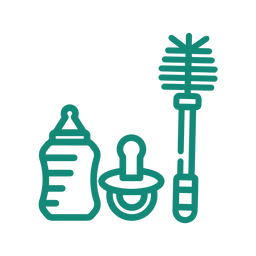 Feeding & Nursing
Feeding & Nursing Safety & Grooming
Safety & Grooming  Bathing & Diapering
Bathing & Diapering Baby Gear
Baby Gear Mother Needs
Mother Needs Muslin Essentials
Muslin Essentials Baby Toys
Baby Toys



